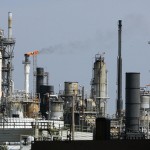Natural gas fell on Monday, extending Fridays losses, as weather forecasts continued to call for overall mild weather across the US to persist, apart from a cooler pattern across the North.
Natural gas for delivery in May traded 1.78% lower at $2.587 per million British thermal units at 8:09 GMT, shifting in a daily range of $2.596-$2.549. The contract slid 1.86% on Friday to $2.634 per mBtu, trimming its weekly advance to 4.9%.
According to NatGasWeather.com, natural gas demand in the US will be low today, before becoming moderate through April 25th, with an overall mild weather trend over the following seven days.
The eastern US will enjoy quite mild weather on Monday with readings in the 60s and 70s, while reaching the upper 70s and 80s south. However, temperatures across the northern US will drop as cooler Canadian air spills across the border on Tuesday. Overnight lows over the Midwest and interior Northeast falling into the 20s and 30s will induce a round of moderate heating demand. However, although reinforcing cool blasts will continue through the end of the month, failing to tap truly cold Polar air will keep natural gas demand limited as the rest of the US enjoys mostly seasonal or warmer weather.
Texas, Florida and the Southeast will warm up after Monday with highs establishing in the 70s and 80s, and locally 90s, while the West remains mostly wild, NatGasWeather.com said.
Active weather will continue across the US next week as well, with a slightly cool Spring pattern. The Midwest and Northeast are anticipated to be slightly cooler than normal, but to warm up around May 1st, while the western, central and southern US enjoy near-seasonal weather.
Readings
According to AccuWeather.com, the high in New York on April 21st will be 68 degrees Fahrenheit, 5 above usual, before easing to the upper 50s and lower 60s through April 30th. Temperatures in Chicago will peak at 56 degrees on April 21st, 6 below normal, and will drop to 51-53 degrees over the following four days.
Down South, Houston will peak tomorrow at the seasonal 80 degrees, before surging to 88 degrees on April 23-24th. On the West Coast, Los Angeles will see readings max out at 66-68 degrees between April 21-25th, followed by a warm-up into the low-mid 70s through the end of the month.
Supplies
The Energy Information Administration reported last Thursday that natural gas stockpiles in the US expanded by 63 billion cubic feet in the week ended April 10th, exceeding analysts’ median estimate for a 53-55 bcf gain. Total gas held in US storage hubs amounted to 1.539 trillion cubic feet, narrowing a deficit to the five-year average of 1.684 trillion to 8.6% from 10.5% a week earlier. Supplies were at a surplus of 81.7% to year-ago inventories of 847 bcf.
This Thursdays inventory report is expected to show a larger-than-average build in stockpiles, around 90-100 billion cubic feet, as overall warm temperatures covered most of the US last week. If confirmed, this would narrow deficits below 100 bcf. The five-year average inventory gain for the week ended April 17th is +46 billion cubic feet, while stockpiles grew by 45 bcf during the comparable period a year earlier.
The following report, due out on April 30th, will likely also reflect a larger-than-normal inventory build as overall mild readings persist. The five-year average build for the week ended April 24th is +55 bcf, while supplies rose by 77 bcf during the comparable period a year earlier.
Pivot points
According to Binary Tribune’s daily analysis, May natural gas futures’ central pivot point stands at $2.651. In case the contract penetrates the first resistance level at $2.676 per million British thermal units, it will encounter next resistance at $2.719. If breached, upside movement may attempt to advance to $2.744 per mBtu.
If the energy source drops below its S1 level at $2.608 per mBtu, it will next see support at $2.583. In case the second key support zone is breached, the power-station fuel’s downward movement may extend to $2.540 per mBtu.
In weekly terms, the central pivot point is at $2.601. The three key resistance levels are as follows: R1 – $2.726, R2 – $2.819, R3 – $2.944. The three key support levels are: S1 – $2.508, S2 – $2.383, S3 – $2.290.





